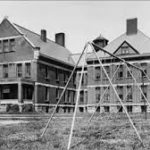Ordinary homes during the late 1800s and well into the 1900s had few conveniences (see last post); unlike homes today, a dedicated bathroom was a luxury. A largely rural population typically used an outhouse, which could be indifferently built at worst and an uncomfortable distance from the home at best. Cold in winter and hot in summer, outhouses could smell unpleasantly, attract flies and other insects, and offer little comfort in the way of washroom amenities and hygiene.
In contrast, insane asylums often provided indoor toilets that included the benefit of indoor plumbing for both flushing and washing. The Canton Asylum for Insane Indians was no exception, even though it opened the last day of 1902 in a remote area of the country.
Canton Asylum’s system used range toilets, which shared a common pipe and flushed all at once. If they weren’t flushed regularly, unpleasant odors (and presumably bacteria) could build up and make the room distasteful to use and unhealthy as well. Unfortunately, attendants were sometimes lax in their flushing intervals, and the toilet area did become distasteful to use.
Some patients may not have known how to use the toilet properly, and sometimes violent patients destroyed part of the equipment. The toilets and lavatory areas were a perpetual headache for asylum superintendent Dr. Harry Hummer, and surely for many of the attendants as well. In time, the washroom system degraded into the fallback use of chamber pots, which were even more unpleasant and unhealthy because they were allowed to fill to overflowing.








